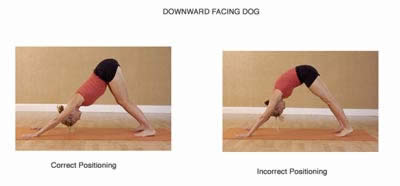Some yoga teachers strive to keep tradition alive by incorporating breathing techniques and chanting. Other instructors are satisfied with simply offering the yoga poses, or asanas, as a method of exercise to keep the body strong, supple and stress free.
Engaging in yoga, as in other life ventures, will produce results proportionate to your efforts and intentions and proper execution of alignment is crucial for optimal physical results. Focusing on the physical aspects of yoga conditions the body and calms the mind, fulfilling the surface expectations many have connected to yoga.
Downward Facing Dog is an essential pose in the majority of yoga classes and is a wonderful pose to increase strength and flexibility for other sports even if you have no interest in group yoga classes.
While learning Downward Facing Dog, and to practice standing yoga poses in general, make sure you are on a non-slip surface such as a yoga mat. Mats are available at sporting goods stores and are inexpensive. If your interest in yoga does not warrant a mat at this time, you may need to experiment with various floor surfaces in your home to find the best place to perform the exercises.
Cats and Dogs
Begin on your hands and knees in an "all fours" position. Adjust hands to be shoulder width apart with knees hip width apart. Position hands directly under the shoulders and knees under the hips. Practice arching and rounding the spine a few times. These movements, called Cat Stretch and Dog Tilt, are common therapeutic exercises.
If you are unsure, think of the "Cat" as drawing your middle back towards the ceiling, spreading your shoulder blades, and pulling your abdominals in and up. The "Dog" is the opposite action of dropping your belly towards the floor, pushing your chest forward, and lifting up the buttocks. Exhaling with the Cat and inhaling with the Dog will allow for greater range of motion and better sensation.
The Dog Tilt, as the name implies, is a warm-up position for Downward Facing Dog. Starting from Dog Tilt, slowly draw your knees off the floor and push your buttocks up and back. You are now on your feet and hands, and will feel the extra strength needed in the arms to hold the pose. Focus on straight arms and try to open your armpits. Allow your head to fall towards the floor by relaxing your neck muscles. You should be looking behind you through your legs.
The shape of the body in Downward Facing Dog resembles an inverted letter "V," with the tailbone representing the point of the "V." In most people, the legs should not be entirely straight because doing so restricts the ability the lift the buttocks, which is necessary for deep stretching in the hamstring muscles.

Photo by: Gonzalo Villota Photography
You may need to adjust the distance between hands and feet. Experiment with walking the feet back or forward an inch or two and notice if you are better able to feel the stretch and/or have better balance.
Trust your natural feelings and keep shifting around for a few moments. When you find the correct footing hold the pose still for five breaths. Drop to your knees to rest and continue with three to five more Downward Facing Dogs, taking liberty to incorporate stretches that you may already regularly perform between or after each Dog.
Benefits: Strengthens arms and back, relieves tension in the neck, and creates flexibility in the hamstrings (back of the thighs) and shoulders.
Cautions: May not be suitable for those with chronic shoulder or wrist pain, undiagnosed lower back problems, and/or untreated high blood pressure.

